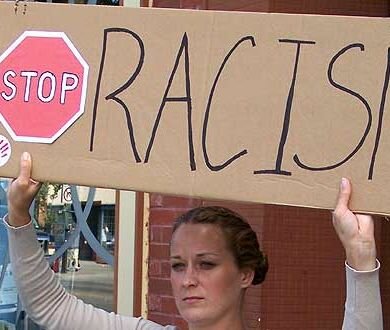How do you Define Racism?
Talk About Race — By Stephen Menendian on March 30, 2010 at 09:26Every couple of months the media is gripped by a remark, outburst or quote from some starlet, politician, or athlete. The question is always: Is so-and-so racist? The most recent iteration of this phenomenon was John Mayer’s Playboy interview, which I recently blogged about. Before that was Rep. Joe Wilson’s comments during President Obama’s health care speech, which I also blogged about. And each time, the debate devolves into intractable disagreement because each side talks past the other. Each side is defining racism differently.
Conservatives and colorblind advocates are quick to label any action or differential treatment based on any racial characteristic under any circumstance as racist. This supports their view that affirmative action programs are racist. From this point of view, voting for someone, such as Barack Obama, because of their race is racist. It’s race-based decision-making.
Progressives are less likely to adopt this definition. One online comment, responding to a Newsweek article on John Mayer’s remarks, offered a different definition:
As far as my understanding of racism, it’s usually a belief that one’s own race is superior, and responding to other races with domination/fear/hatred/subjugation. So, how is attraction to a particular race, well, racism? This idea of attraction is not laced with domination, subjugation, fear and hatred of other races.
As a bi-racial female, I’m attracted to Caucasian males, but this attraction to white males does not make me hate, fear or want to dominate other races, they just don’t do it for me most of the time…? I’ve dated Hispanics, Asians, and African Americas, but my base attraction is towards white males. So again I ask, where does racism step in? I don’t hate black men, and if I were single and a black guy showed interest in me and there was chemistry, hell yeah I’d have no problem dating him. But because my preference is towards white guys that’s…racist? How?
How can we resolve these different definitions of racism, one that contends that any race-based decision-making is racist, and the other than says that only malicious race-based decision-making is racist?
The dictionary doesn’t seem to offer a clear answer:
(1) : a belief that race is the primary determinant of human traits and capacities and that racial differences produce an inherent superiority of a particular race
(2) : racial prejudice or discrimination
The first definition would seem to confirm the young lady’s view of racism as a belief in the superiority and inferiority of particular races, and apply to actions consistent with those beliefs. Applying this definition, remedial affirmative action measures are not racist. But what about the alterantive definition, “(2): Racial Prejudice or discrimination”? It depends on how the dictionary defines ‘prejudice’ or ‘discrimination.’ Let’s look them up:
(1)( a): the act of discriminating (b): the process by which two stimuli differing in some aspect are responded to differently
(2): the quality or power of finely distinguishing
(3)(a): the act, practice, or an instance of discriminating categorically rather than individually
(3)(b): prejudiced or prejudicial outlook, action, or treatment <racial discrimination>
(1) and (2) would seem to confirm the colorblind definition of racism. Discrimination is simply distinguishing between two stimuli. Racial discrimination, it would seem, would be distinguishing between things on the basis of race.
But (3)(b) signals a more specific term, racial discrimination, and provides two definitions. (3)(a) would seem to be the conservative, colorblind definition. But (3)(b) suggests something different. We need to look up one more word:
(1): injury or damage resulting from some judgment or action of another in disregard of one’s rights ; especially : detriment to one’s legal rights or claim
(2) (a) (1): preconceived judgment or opinion (2): an adverse opinion or leaning formed without just grounds or before sufficient knowledge
(b): an instance of such judgment or opinion
(c): an irrational attitude of hostility directed against an individual, a group, a race, or their supposed characteristics
(2)(c) specifically references race, and defines prejudice as an “irrational attitude of hostility.” Putting it all together, the dictionary definition of racism may be: “Prejudicial or prejudiced outlook, action, or treatment,” where prejudice means “an irrational attitude of hostility directed against a race, or their supposed characteristics.” This particular definition would seem consistent with the young woman’s view of racism.
As you can see, the dictionary is of little help in resolving this debate. Unfortunately, the dictionary gives us more than one definition of racism. The problem is that different definitions can be used to support each conception of racism. Far from resolving the dispute, the dictionary cements it.
My view is that there is a difference between race-based decision making that is motivated by racial prejudice or malice and race-based decision-making that is motivated by beneficence or a remedial purpose, between outright racial bigotry and a good-faith attempt to open the door of opportunity to those that have been and continue to be marginalized or disadvantaged. That is, there is a difference between Jim Crow and Affirmative Action programs, between a “welcome mat” and a “no trespassing sign.”[i] After all, if race-based decision making is racist, then the Court in Brown, by ordering a race-conscious integration remedy, was racist. And any Title VII remedy, which takes cognizance of a plaintiff’s race, must also be racist, since it awards damages because of a person’s race.
Regardless of your views, of whether you think affirmative action programs, voting for Obama (at least in part) because of his race, or John Mayer’s comments are racist, we should begin by acknowledging that we may have different definitions of what racism means. Only when we begin to explore our varying definitions and meanings, and debate the merits of our respective definitions, can we begin to talk to each other and not past each other.
How do you define racism, and why?
[i] This was the analogy brilliantly suggested by Justice John Paul Stevens in his dissenting opinion in Adarand Constructors Inc. v. Pena, 515 U.S. 200, (1995):
“The consistency that the Court espouses would disregard the difference between a “No Trespassing” sign and a welcome mat. It would treat a Dixiecrat Senator’s decision to vote against Thurgood Marshall’s confirmation in order to keep African Americans off the Supreme Court as on a par with President Johnson’s evaluation of his nominee’s race as a positive factor. It would equate a law that made black citizens ineligible for military service with a program aimed at recruiting black soldiers. An attempt by the majority to exclude members of a minority race from a regulated market is fundamentally different from a subsidy that enables a relatively small group of newcomers to enter that market. An interest in “consistency” does not justify treating differences as though they were similarities.”
Tags: race, racial, racism, Talking about RaceAuthor: Stephen Menendian (12 Articles)

Stephen Menendian is the senior legal research associate at the Kirwan Institute for the Study of Race and Ethnicity at the Ohio State University. Stephen directs and supervises the Institute’s legal advocacy, analysis and research, and manages many of the Institute’s most important projects. His principal areas of advocacy and scholarship include education, civil rights and human rights, Constitutional law, the racialization of opportunity structures, talking about race, systems thinking and implicit bias. Stephen co-manages the Institute’s Integration Initiative to promote diversity, reduce racial isolation, improve funding equity, and close the achievement gap in our nation’s public schools. Stephen works closely with school districts and other educational entities to develop successful integrative measures and implement practices that produce educational excellence for all students. Stephen also co-manages the Institute’s Fair Recovery Project (www.fairecovery.org) to ensure that federal initiatives and investments promote equity and equal opportunity for all, and that jobs and foreclosure relief target those who have been hit hardest by the economic downturn. Stephen also directs the Institute’s Affirmative Action Project and was the lead author of the Institute’s Structural Racism Report to the CERD Committee to improve US treaty compliance with the Convention for the Elimination of Racial Discrimination. Recent scholarly publications include Parents Involved: The Mantle of Brown, the Shadow of Plessy for the University of Louisville Law Review and the forthcoming Remaking Law: Moving Beyond Enlightenment Jurisprudence for the St. Louis University Law Review. Stephen occasionally guest-lectures at the Moritz College of Law, and co-taught The History and Culture of Race and Law, a seminar at Wayne State University Law School, in the fall of 2009. Stephen is a licensed attorney and a member of the Ohio State Bar Association, the Columbus Bar Association, and the American Bar Association. He also serves on the board of directors for Americans for American Values. He earned his J.D. from the Moritz College of Law, Ohio State University and a B. A. in Economics from Ohio University, where he graduated summa cum laude.



 Share This
Share This Tweet This
Tweet This Digg This
Digg This Save to delicious
Save to delicious Stumble it
Stumble it





 For Ayiti (Haiti)
For Ayiti (Haiti) Something precious is missing
Something precious is missing








1 Comment
International human rights law (the United Nations International Convention on the Elimination of All Forms of Racial Discrimination) can shed some light in answering this question. According to CERD Article 1(1), “racial discrimination” encompasses both intentional, or de jure discrimination as well as discrimination in effect (or racially disparate impact). Under international law, the former (“intent”) is a subjective measure of discrimination whereas the latter (“de facto discrimination”) is an objective measure of whether discrimination exists within a social system. As such, intentional or purposeful discrimination doesn’t have to be present: by itself, racially disproportionate impact in any area of political, economic, social, or cultural life, is a sufficient indication of a “racially discriminatory” system.
As Americans we often have a great deal of trouble understanding and accepting the latter (de facto discrimination). Many of us like to think that as long as we don’t mean or to be “racist,” and as long as we treat everyone the same regardless of their race (i.e. become “color-blind”), then racism can no longer exist. But this is an oversimplification of factual realities.
Conceptually speaking, the notion of “de facto discrimination” is necessary in an hermetic definition of racial discrimination, that without which, we (or any other social system) can never have an objective measure of whether discrimination actually exists. After all, “bias” and “prejudice” (and “discrimination”) are subjective in nature. This is a conceptual exercise that if you really think about – makes a lot of sense.
For example, work backwards from something that doesn’t have a discrimination problem: there’s currently no disparate impact (or intentional discrimination) along ear sizes. But if one day people begin noticing that those with big ears are disproportionately impacted in one or all areas of social life – then it would only make sense for everyone to question and critically examine the external system in which they inhabit. To merely accept the status quo would be to accept the notion that having big ears is on some levels inherently linked with – and therefore justifies – existing disparities. This would then bring us back to the subjective notion of bias and prejudice, regardless of conscious, purposeful intent.
Similarly, the concept of disparate impact could be used to examine racial stereotypes, preferences and assumptions. Regardless of whether conscious intent exists, disparate impact on people along a (Western) socially-constructed characteristic should raise a host of questions: a lot of times people’s justifications of the status quo are based on stereotypes and assumptions that they are unwilling to examine. We have to recognize that stereotypes are not by themselves “objective truths” and that our personal preferences aren’t purely rational – they are rooted in or are influenced by one group’s (i.e. the dominant group’s) subjective perceptions and beliefs about another (i.e. a non-dominant) group. As such, these assumptions and belief are by nature subjective. These perceptions and their resulting behavior – from the level of policy decision-making to personal interactions on an individual basis – have very real, concrete, implications for individuals from minority groups (for example, drug-law policies; Claude Steele’s research on stereotype threats; Derald Wing Sue’s Microaggressions in Everyday Life: Race, Gender, and Sexual Orientation (2010)).
In a society where racially disproportionate impact is found in all areas of life, perhaps a good question to ask ourselves would be why do our minds frame certain issues (e.g. “reverse racism”/”affirmative action”) in ways that they do when there are other just as “objective” ways of framing those issues? And why do we have personal preferences along the lines of race and color? This can also be applied to a society’s standard for beauty – what implicit messages are we getting from the larger society including the media, our social/peer groups, educational systems, as well as our lives in the private sphere?
The Implicit Project at Harvard as well as other studies in social psychology have documented that unconscious, implicit biases and their effects on people’s conduct, including preferences and decision-making. Malcolm Gladwell points this out in his book “Blink” in examining wrongful police shootings, but insists that this is “not racist”. Similarly, scholars in various academic disciplines prefer to use the word “racialized” instead of “racist” due to the various connotations and meanings that have emerged over the years.
As the public understanding of “racism” continues to evolve in the United States, international law – with an air-tight definition for “racial discrimination” – provides the best and most effective answer. Racially disparate impact is the measure at which we should be defining what is “racist” and what is not. As along as racial disparities continue to exist – in housing, health care, employment, criminal system, education, politics, legal system, etc. – we are inhabiting a racially discriminatory society. As such, most of us – on various levels (e.g. consciously and unconsciously) – end up accepting some notions of bias – and this is not okay. The uncomfortable truth remains that we still live in a very racist society as race continues to raise a host of dire human rights violations in our country.